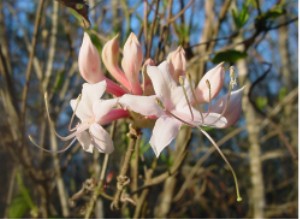
Rhododendron is a very large genus of about 1,024 species of woody plants in the heath family (Ericaceae). They can be either evergreen or deciduous. Most species are native to eastern Asia and the Himalayan region, but smaller numbers occur elsewhere in Asia, and in North America, Europe and Australia.

Azaleas are flowering shrubs in the genus Rhododendron, particularly the former sections Tsutsusi (evergreen) and Pentanthera (deciduous). Azaleas bloom in the spring, their flowers often lasting several weeks. Shade tolerant, they prefer living near or under trees. They are part of the family Ericaceae.

Rhododendron atlanticum, the dwarf azalea or coastal azalea, is a species of Rhododendron native to coastal areas of the eastern United States, from New Jersey south to Georgia.

Rhododendron canadense, the rhodora or Canada rosebay, is a deciduous flowering shrub that is native to northeastern North America.

Rhododendron groenlandicum is a flowering shrub with white flowers and evergreen leaves that is used to make a herbal tea.

Rhododendron occidentale, the western azalea or California azalea, is one of two deciduous Rhododendron species native to western North America. The western azalea is known to occur as far north as Lincoln and Douglas Counties in Oregon and as far south as the mountains of San Diego county. Typically found in the coastal ranges of western North America, it also grows in the Cascade and Sierra Nevada mountain ranges, but is not known east of them.

Rhododendron luteum, the yellow azalea or honeysuckle azalea, is a species of flowering plant in the heath family Ericaceae, native to southeastern Europe and southwest Asia. In Europe, it occurs from southern Poland and Austria, south through the Balkans, and east to southern Russia; and in Asia, east to the Caucasus.

Rhododendron catawbiense, with common names Catawba rosebay, Catawba rhododendron, mountain rosebay, purple ivy, purple laurel, purple rhododendron, red laurel, rosebay, rosebay laurel, is a species of Rhododendron native to the eastern United States, growing mainly in the southern Appalachian Mountains from Virginia south to northern Alabama.

Rhododendron maximum is a species of Rhododendron native to the Appalachians of eastern North America, from Alabama north to coastal Nova Scotia. Its common names include great laurel, great rhododendron, rosebay rhododendron, American rhododendron and big rhododendron.

Rhododendron schlippenbachii, the royal azalea, is a species of Rhododendron native to the Korean Peninsula and adjacent regions of Northeast China, Japan, and the Russian Far East. It is the dominant understory shrub in many Korean hillside forests, growing at 400–1,500 m (1,300–4,900 ft) altitude.

Rhododendron calendulaceum, the flame azalea, is a species of Rhododendron. It is a deciduous shrub that grows up to 120–450 cm tall. This species of Rhododendron is native to the Appalachian Mountains in the eastern United States, ranging from southern Pennsylvania and Ohio to northern Georgia. It may be extirpated from Pennsylvania and Alabama. It occurs naturally in mixed deciduous forests and is typically found in woodland slopes and mountain balds in the Appalachians, where it prefers dry and rocky mountain woods. The inflorescences of Rhododendron calendulaceum are visited by many animals such as bees, butterflies, hummingbirds and small mammals. It is a popular cultivated plant due to its bright yellow, orange or red flowers.

Rhododendron macrophyllum, the Pacific rhododendron, California rosebay, California rhododendron, coast rhododendron or big leaf rhododendron, is a large-leaved species of Rhododendron native to the Pacific Coast of North America. It is the state flower of Washington.

Rhododendron viscosum, the swamp azalea, clammy azalea or swamp honeysuckle, is a species of flowering plant in the heath family Ericaceae. This deciduous shrub, growing to 2.5 m (8.2 ft) tall and broad, is native to the eastern United States. It has rounded matt green leaves. In early summer it produces funnel-shaped white flowers flushed pink. The flowers have prominent stamens and are strongly fragrant.

Rhododendron menziesii, also classified as Menziesia ferruginea, is a species of flowering plant in the heath family Ericaceae, known by several common names, including rusty menziesia, false huckleberry, fool's huckleberry and mock azalea.

Rhododendron periclymenoides, the pink azalea or pinxter flower, is a species of shrub in the heath family Ericaceae. It is native to eastern North America, where it is widespread from Alabama to New Hampshire. It is often found in riparian areas, in wet to dry forests.

Rhododendron arborescens, also known as smooth azalea or sweet azalea, is a species of flowering plant in the family Ericaceae, native to the eastern seaboard of the United States.

Rhododendron austrinum is a species of flowering plant in the heath family known by the common names Florida flame azalea, honeysuckle azalea, southern yellow azalea, and orange azalea. It is native to the southern United States, where it can be found in Alabama, Florida, Georgia, and Mississippi. It is also a common ornamental plant.

Rhododendron vaseyi is a species of flowering plant in the heath family known by the common name pinkshell azalea. It is endemic to the Appalachian highlands of North Carolina in widely scattered locations. While there is a main center of distribution west of Asheville, there is also a large population on Grandfather Mountain, in the northwestern corner of the state.

Rhododendron minus var. minus, the Carolina azalea or Carolina rhododendron, is a rhododendron species native to the mountains of North Carolina, South Carolina, Tennessee, and Northeast Georgia. It is commonly known as Rhododendron carolinianum in the horticultural trade.

North American azaleas are flowering shrubs in the genus Rhododendron, section Pentanthera, subsection Pentanthera, so named because they all have five stamens. Most are in the United States, with one species found in Canada and one being found in Mexico. North American azaleas are commonly confused with azaleas of Asian origin, the evergreen azaleas. North American azaleas are deciduous and produce two types of buds. One is a larger and produces about 20 flowers while the other bud produces a leafy shoot. The flower color, fragrance, and number of stamens vary among species.



















